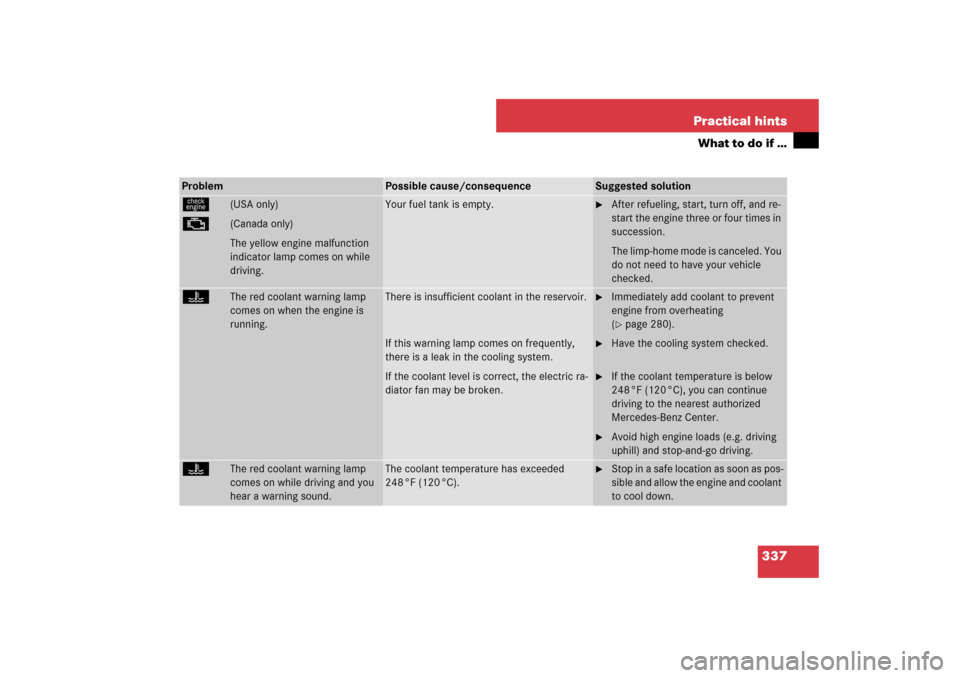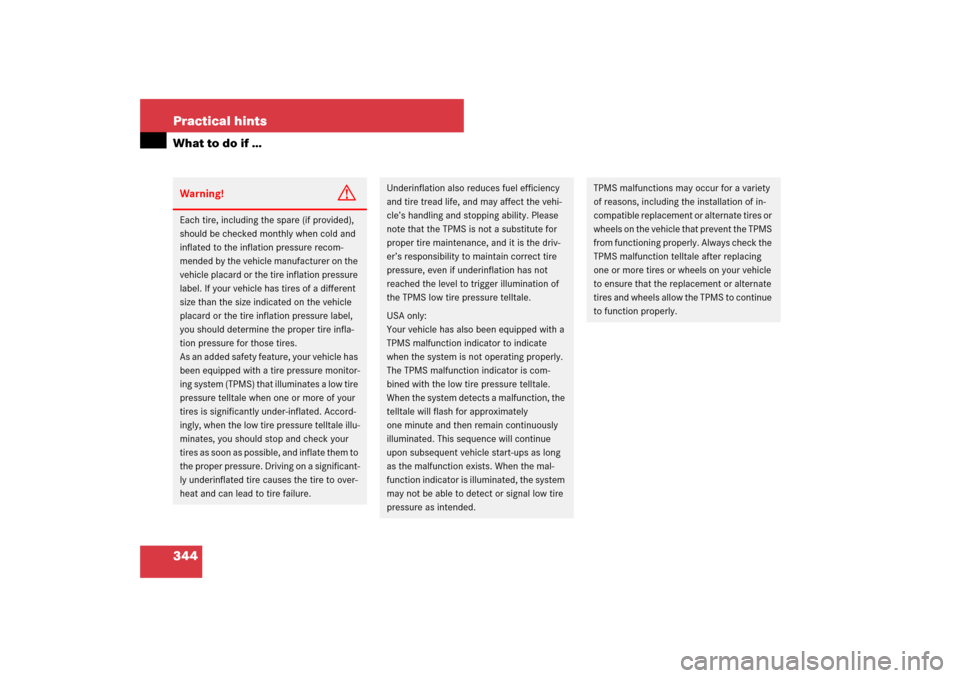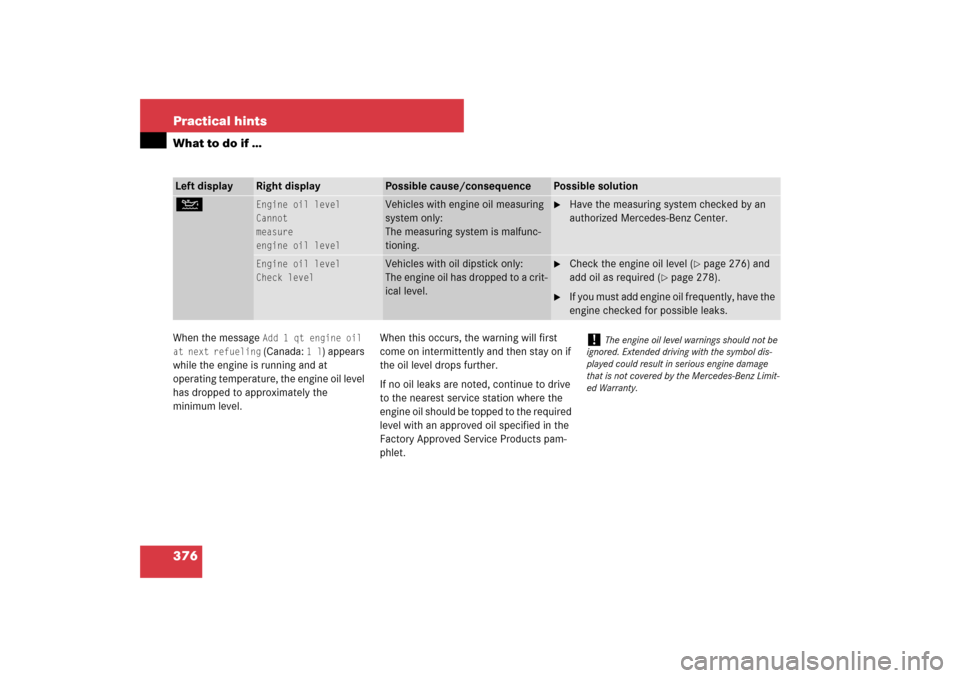Page 338 of 473

337 Practical hints
What to do if …
Problem
Possible cause/consequence
Suggested solution
ú
(USA only)
±
(Canada only)
The yellow engine malfunction
indicator lamp comes on while
driving.
Your fuel tank is empty.
�
After refueling, start, turn off, and re-
start the engine three or four times in
succession.
The limp-home mode is canceled. You
do not need to have your vehicle
checked.
D
The red coolant warning lamp
comes on when the engine is
running.
There is insufficient coolant in the reservoir.
If this warning lamp comes on frequently,
there is a leak in the cooling system.
If the coolant level is correct, the electric ra-
diator fan may be broken.
�
Immediately add coolant to prevent
engine from overheating
(�page 280).
�
Have the cooling system checked.
�
If the coolant temperature is below
248 °F (120 °C), you can continue
driving to the nearest authorized
Mercedes-Benz Center.
�
Avoid high engine loads (e.g. driving
uphill) and stop-and-go driving.
D
The red coolant warning lamp
comes on while driving and you
hear a warning sound.
The coolant temperature has exceeded
248 °F (120 °C).
�
Stop in a safe location as soon as pos-
sible and allow the engine and coolant
to cool down.
Page 340 of 473
339 Practical hints
What to do if …
Problem
Possible cause/consequence
Suggested solution
E
The white Distronic* indicator
lamp comes on while driving.
The Distronic* distance sensor has recog-
nized a preceding vehicle.
E
The red distance warning lamp
comes on while driving and you
hear a warning sound.
�
You are gaining too rapidly on the vehicle
ahead of you.
�
The distance warning system has recog-
nized a stationary obstacle on your prob-
able line of travel.
�
Apply the brakes immediately.
�
Carefully observe the traffic situation.
You may need to brake or maneuver
to avoid hitting an obstacle.
A
The yellow fuel tank reserve
warning lamp lights while driv-
ing.
The fuel level has dropped below the reserve
mark.
�
Refuel at the next gas station
(�page 271).
The fuel cap is not closed tightly.
�
Check the fuel cap (
�page 271).
Page 345 of 473

344 Practical hintsWhat to do if …Warning!
G
Each tire, including the spare (if provided),
should be checked monthly when cold and
inflated to the inflation pressure recom-
mended by the vehicle manufacturer on the
vehicle placard or the tire inflation pressure
label. If your vehicle has tires of a different
size than the size indicated on the vehicle
placard or the tire inflation pressure label,
you should determine the proper tire infla-
tion pressure for those tires.
As an added safety feature, your vehicle has
been equipped with a tire pressure monitor-
ing system (TPMS) that illuminates a low tire
pressure telltale when one or more of your
tires is significantly under-inflated. Accord-
ingly, when the low tire pressure telltale illu-
minates, you should stop and check your
tires as soon as possible, and inflate them to
the proper pressure. Driving on a significant-
ly underinflated tire causes the tire to over-
heat and can lead to tire failure.
Underinflation also reduces fuel efficiency
and tire tread life, and may affect the vehi-
cle’s handling and stopping ability. Please
note that the TPMS is not a substitute for
proper tire maintenance, and it is the driv-
er’s responsibility to maintain correct tire
pressure, even if underinflation has not
reached the level to trigger illumination of
the TPMS low tire pressure telltale.
USA only:
Your vehicle has also been equipped with a
TPMS malfunction indicator to indicate
when the system is not operating properly.
The TPMS malfunction indicator is com-
bined with the low tire pressure telltale.
When the system detects a malfunction, the
telltale will flash for approximately
one minute and then remain continuously
illuminated. This sequence will continue
upon subsequent vehicle start-ups as long
as the malfunction exists. When the mal-
function indicator is illuminated, the system
may not be able to detect or signal low tire
pressure as intended.
TPMS malfunctions may occur for a variety
of reasons, including the installation of in-
compatible replacement or alternate tires or
wheels on the vehicle that prevent the TPMS
from functioning properly. Always check the
TPMS malfunction telltale after replacing
one or more tires or wheels on your vehicle
to ensure that the replacement or alternate
tires and wheels allow the TPMS to continue
to function properly.
Page 375 of 473
374 Practical hintsWhat to do if …Left display
Right display
Possible cause/consequence
Possible solution
Check doors
2
You are attempting to drive with
one or more doors open.
�
Close the doors.
Vehicles with KEYLESS-GO*:
You are pressing the lock button on
the door handle and at least one
door is open.
±
Visit
workshop
Certain electronic systems are un-
able to relay information to the con-
trol system. The following systems
may have failed:�
Coolant temperature gauge
�
Tachometer
�
Have the electronic systems checked by an
authorized Mercedes-Benz Center
(�page 336).
Engine
Service
There may be a malfunction in the �
fuel injection system
�
ignition system
�
exhaust system
�
fuel system
�
Have the engine checked as soon as possible
by an authorized Mercedes-Benz Center
(�page 336).
Page 376 of 473

375 Practical hints
What to do if …
Left display
Right display
Possible cause/consequence
Possible solution
_
Entry position
Do not drive
The steering wheel has not yet
moved into its stored driving posi-
tion.
�
Wait until the steering wheel has moved to its
driving position.
The message disappears.
N
USA only:Add 1 qt. engine oil
at next refuelingCanada only:Add 1 liter
engine oil
at next refueling
Vehicles with engine oil measuring
system only:
The engine oil level is too low.
�
Add engine oil (
�page 278) and check the
engine oil level (�page 276).
Engine oil level
Stop car –
turn engine off
Vehicles with engine oil measuring
system only:
There is no oil in the engine. There
is a danger of engine damage.
�
Stop the vehicle in a safe location or as soon
as it is safe to do so.
�
Turn off the engine.
�
Add engine oil (
�page 278) and check the
engine oil level (�page 276).
Engine oil level
Reduce
oil level
Vehicles with engine oil measuring
system only:
You have added too much engine
oil. There is a risk of damaging the
engine or the catalytic converter.
�
Have excess oil siphoned or drained off. Ob-
serve all legal requirements with respect to its
disposal.
Page 377 of 473

376 Practical hintsWhat to do if …When the message
Add 1 qt engine oil
at next refueling (Canada:
1l
) appears
while the engine is running and at
operating temperature, the engine oil level
has dropped to approximately the
minimum level.When this occurs, the warning will first
come on intermittently and then stay on if
the oil level drops further.
If no oil leaks are noted, continue to drive
to the nearest service station where the
engine oil should be topped to the required
level with an approved oil specified in the
Factory Approved Service Products pam-
phlet.
Left display
Right display
Possible cause/consequence
Possible solution
N
Engine oil level
Cannot
measure
engine oil level
Vehicles with engine oil measuring
system only:
The measuring system is malfunc-
tioning.
�
Have the measuring system checked by an
authorized Mercedes-Benz Center.
Engine oil level
Check level
Vehicles with oil dipstick only:
The engine oil has dropped to a crit-
ical level.
�
Check the engine oil level (
�page 276) and
add oil as required (
�page 278).
�
If you must add engine oil frequently, have the
engine checked for possible leaks.
!
The engine oil level warnings should not be
ignored. Extended driving with the symbol dis-
played could result in serious engine damage
that is not covered by the Mercedes-Benz Limit-
ed Warranty.
Page 378 of 473
377 Practical hints
What to do if …
Left display
Right display
Possible cause/consequence
Possible solution
A
Fuel cap
open
A loss of pressure has been detect-
ed in the fuel system. The fuel cap
may not be closed properly or the
fuel system may be leaky.
�
Check the fuel cap (
�page 271).
If it is not closed properly:
�
Close the fuel cap.
If it is closed properly:
�
Have the fuel system checked by an autho-
rized Mercedes-Benz Center.
K
being lowered
The retractable hardtop is not com-
pletely opened or closed. The roof
hydraulics will start to lose pres-
sure.
�
Make sure the retractable hardtop is com-
pletely opened or closed (
�page 199).
locked
in driving mode
You have attempted to open the re-
tractable hardtop while driving.
�
Stop the vehicle in a safe location and try to
open the hardtop again.
O
You are driving with the hood open.
Risk of accident!�
Stop the vehicle in a safe location or as soon
as it is safe to do so.
�
Close the hood (
�page 275).
Page 394 of 473

393 Practical hints
Locking/unlocking in an emergency
Locking the vehicle
If you cannot lock the vehicle with the
SmartKey, lock it with the mechanical key
as follows:�
Close the passenger door and the
trunk.
�
Press the central locking switch in the
center console (
�page 119).
�
Check whether the locking knob on the
passenger door has moved down.
�
If necessary push it down manually.
�
Remove the mechanical key from of
the SmartKey (
�page 391).
�
Check whether the trunk is locked.
�
If necessary, lock the trunk with the
mechanical key (
�page 117).
Except for the driver’s door, the vehicle
should now be locked.1Locking
2Mechanical key
�
Insert mechanical key 2 (
�page 391)
into the driver’s door lock until it stops.
�
Turn mechanical key 2 clockwise to
position 1.
The driver’s door is locked.
i
Unlocking the glove box with the mechanical
key will trigger the anti-theft alarm system. To
cancel the alarm, do one of the following:
�
Press button Œ or ‹ on the
SmartKey.
�
Insert the SmartKey in the starter switch.
�
Press the KEYLESS-GO* start/stop button
(�page 40).
�
Grasp an outside door handle (vehicles with
KEYLESS-GO* only).
i
This procedure does not arm the anti-theft
alarm system, nor does it lock the fuel filler flap
and the storage compartments.
The storage compartments can be locked
separately (
�page 235).